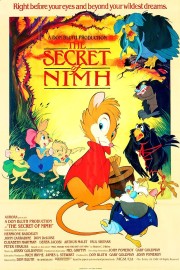The Secret of NIMH
One thing that’s occurred to me not only in watching my second Don Bluth animated film for this “Movie a Week” series, and thinking about his work in general, is that Bluth, one of the few, independent animators in Hollywood (which is to say, he wasn’t making films for Disney or another major animation house) may have been making films for target family audiences, but there’s a maturity and dramatic nature to the animation, and the storytelling, that set it apart from the Disneys and now, the Dreamworks and Blue Sky films. (Although each of those have dabbled in more dramatic efforts over the years.) I should mention that I’m referring to Bluth in the past tense not because he’s died, because he hasn’t, but because his last film was the 2000 bomb, “Titan A.E.”; that’s a long drought. Rewatching “An American Tail” and today’s film, “The Secret of NIMH,” makes me realize just how unfortunate that is for American animation.
As much as I’ve enjoyed “An American Tail” over the years, I think “NIMH,” based on the novel, Mrs. Frisby and the Rats of NIMH, by Robert C. O’Brien is probably his best film. The film has an emotional core that draws us in, while the escalating tension of the story builds to a dramatic climax that rivals anything we’ve seen in the best animated films of the past 30 years.
The film, for those who have either never seen it, or perhaps forgotten it, is about the plight of a widowed mother mouse named Mrs. Frisby (voiced by Elizabeth Hartman). Her husband, Jonathan, has died recently, and her son, Timothy, is very ill. She goes to see Mr. Ages (Arthur Malet), who tells her that he has pneumonia. As if that wasn’t unfortunate enough, her and her family are going to have to move from their home sooner than expected, as the seasons are changing, and the farmer whose land they live on is going to begin running the tractor. That wouldn’t be so bad, except that Timothy is too ill to move; their entire home, which is a cinder block, will need to move. After a trip to The Great Owl, she finds that she has to go to the rats of NIMH for help moving the block. Unfortunately, there’s a power struggle within the rats between the wise Nicodemus (voiced by Derek Jacobi) and the militaristic Jenner (Paul Shenar), which will come to a head during the move, putting the Frisby clan in the middle.
Bluth and his collaborators do a great job with bringing O’Brien’s story to life with powerful visuals. This may be a G-rated “family” film, but there are some truly terrifying images in the film, such as the lair of The Great Owl (which, in look, matches perfectly with John Carradine’s voice); the flashback of the rat’s captivity in NIMH, a scientific laboratory where they were experimented on; as well as the imagery during the rain-soaked move of the Frisby house. At his heart, Bluth may still be a Disney animator, but he also seems to want to move into Ralph Bakshi territory, as well. Don’t worry, though, parents– Bluth (who also directed the first “The Land Before Time,” “All Dogs Go to Heaven,” and “Anastasia”) is working safely within the parameters of family cinema. I mean, he has Dom De Luise (sorely missed) as a bumbling crow who is collecting string for a love nest; not exactly the thing you’d find in movies like Bakshi’s “American Pop” or “Fritz the Cat.”
Dramatic stories in mainstream American animation seem to be taboo (witness the recent apathy towards Blue Sky’s “Epic” and Dreamworks’s criminally-underrated “Spirit: Stallion of the Cimarron”), although plenty of less comedically-driven smashes do exist, such as “Up,” “Wall-E,” “The Nightmare Before Christmas,” and “How to Train Your Dragon.” In a way, all of these films owe Bluth a debt of gratitude for helping push animation away from the Disney formula of happy stories and easy comedy into a more grown-up way of telling stories for kids. More than any other film he’s made, “The Secret of NIMH” shows that this filmmaker is capable of great storytelling, not to mention a distinctly strong visual style that is accessible for all.










